Enterobacteriaceae Isolates from Clinical and Household Tap Water Samples: Antibiotic Resistance, Screening for Extended-Spectrum, Metallo- and AmpC-Beta-Lactamases, and Detection of blaTEM, blaSHV and blaCTX-M in Uyo, Nigeria
Abstract
Introduction
Methods
Collection of tap water and clinical samples
Inclusion criteria
Exclusion criteria
Bacteriological analysis of clinical samples
Detection of Enterobacteriaceae isolates in tap water
Identification of Enterobacteriaceae isolates
Antibiotic susceptibility testing
Screening of extended spectrum β-lactamase (ESBL) producers
Screening of metallo β-lactamase(MBL) and AmpC-βL producers
Extraction of genomic DNA of isolates
PCR amplification of β-lactamase genes in Enterobacteriaceae isolates
Statistical analysis
Results
Discussion
Conclusions
Author Contributions
Institutional Review Board Statement
Acknowledgments
Conflicts of Interest
References
- Qadi, M.; Alhato, S.; Khayyat, R.; Elmanama, A.A. Colistin resistance among Enterobacteriaceae isolated from clinical samples in Gaza Strip. Can J Infect Dis Med Microbiol 2021, 2021, 6634684. [Google Scholar] [CrossRef]
- Kameyama, M.; Yabata, J.; Nomura, Y.; Tominaga, K. Detection of CMY-2 AmpC beta-lactamase- producing enterohemorrhagic Escherichia coli O157:H7 from outbreak strains in a nursery school in Japan. J Infect Chemother 2015, 21, 544–546. [Google Scholar] [CrossRef] [PubMed]
- Thenmozhi, S.; Moorthy, K.; Sureshkumar, B.T.; Suresh, M. Antibiotic resistance mechanism of ESBL producing Enterobacteriaceae in clinical field: A review. Int J Pure App Biosci 2014, 2, 207–226. [Google Scholar]
- Etukudo, I.U.; Onyeagba, R.A.; Akinjogunla, O.J.; Ibe, C.; Ikpe, M.E. Phenotypic expression of extended spectrum βeta-lactamases and antibiogram of uro-pathogenic bacterial isolates from out- patients attending some private hospitals in Uyo, Nigeria. Sci World Jour 2020, 15, 59–66. [Google Scholar]
- Akinjogunla, O.J.; Eghafona, N.O.; Enabulele, I.O. Aetiologic agents of acute otitis media (AOM): Prevalence, antibiotic susceptibility, β-lactamase (βL) and extended spectrum β-lactamase (ESBL) production. J Microbiol Biotechnol Food Sci 2012, 1, 333–353. [Google Scholar]
- Biradar, S.; Roopa, C. Prevalence of metallo-β-lactamase producing Pseudomonas aeruginosa and its antibiogram in a tertiary care centre. Int J Curr Microbiol Appl Sci 2015, 4, 952–956. [Google Scholar]
- Akinjogunla, O.J.; Divine-Anthony, O. Asymptomatic bacteriuria among apparently healthy undergraduate students in Uyo, South- South, Nigeria. Ann Res Rev Biol 2013, 3, 213–225. [Google Scholar]
- Ibrahim, I.A.J.; Hameed, T.A.K. Isolation, characterization and antimicrobial resistance patterns of lactose-fermenter Enterobacteriaceae isolates from clinical and environmental samples. Open J Med Microbiol 2015, 5, 169–176. [Google Scholar] [CrossRef]
- Kateregga, J.N.; Kantume, R.; Atuhaire, C.; Lubowa, M.N.; Ndukui, J.G. Phenotypic expression and prevalence of ESBL-producing Enterobacteriaceae in samples collected from patients in various wards of Mulago hospital, Uganda. BMC Pharmacol Toxicol 2015, 16, 14. [Google Scholar] [CrossRef]
- Nijssen, S.; Florijn, A.; Bonten, M.J.; Schmitz, F.J.; Verhoef, J.; Fluit, A.C. Beta-lactam susceptibilities and prevalence of ESBL-producing isolates among more than 5000 European isolates. Int J Antimicrob Agents 2004, 24, 585–591. [Google Scholar] [CrossRef]
- Abera, B.; Kibret, M.; Mulu, W. Extended-spectrum beta-lactamases and antibiogram in Enterobacteriaceae from clinical and drinking water sources from Bahir Dar city, Ethiopia. PLoS ONE 2016, 11, e0166519. [Google Scholar] [CrossRef]
- Hoang, T.H.; Wertheim, H.; Minh, N.B.; et al. Carbapenem-resistant Escherichia coli and Klebsiella pneumoniae strains containing New Delhi metallo-β-lactamase isolated from two patients in Vietnam. J Clin Microbiol 2013, 51, 373–374. [Google Scholar] [CrossRef]
- Chaudhary, A.K.; Bhandari, D.; Amatya, J.; Chaudhary, P.; Acharya, B. Metallo-beta-lactamase producing Gram-negative bacteria among patients visiting Shahid Gangalal National Heart Centre. Austin J Microbiol 2016, 2, 1010. [Google Scholar]
- Singhal, S.; Mathur, T.; Khan, S.; et al. Evaluation of methods for AmpC beta-lactamase in Gram negative clinical isolates from tertiary care hospitals. Indian J Med Microbiol 2005, 23, 120–124. [Google Scholar] [CrossRef]
- Ratna, A.K.; Menon, I.; Kapur, I.; Kulkarni, R. Occurrence and detection of AmpC beta-lactamases at a referral hospital in Karnataka. Indian J Med Res 2003, 118, 29–32. [Google Scholar]
- Mansouri, S.; Samaneh, A. Prevalence of multiple drug resistant clinical isolates of extended spectrum beta-lactamase producing Enterobacteriaceae in Southeast Iran. Iran J Med Sci 2010, 35, 101–108. [Google Scholar]
- Modakkas, E.M.; Sanyal, S.C. Imipenem resistance in Gram-negative bacteria. J Chemother 1998, 10, 97–101. [Google Scholar] [CrossRef]
- Simsek, M. Determination of the antibiotic resistance rates of Serratia marcescens isolates obtained from various clinical specimen. Niger J Clin Pract 2019, 22, 125–130. [Google Scholar] [CrossRef] [PubMed]
- Singh, L.; Cariappa, M.P.; Kaur, M. Klebsiella oxytoca: An emerging pathogen? Med J Armed Forces India 2016, 72 (Suppl. 1), S59–S61. [Google Scholar] [CrossRef] [PubMed]
- Kibret, M.; Abera, B. Antimicrobial susceptibility patterns of E. coli from clinical sources in Northeast Ethiopia. Afr Health Sci 2011, 11 (Suppl. 1), 40–45. [Google Scholar] [CrossRef] [PubMed]
- Walsh, T.R. Emerging carbapenemases: A global perspective. Int J Antimicrob Agents 2010, 36 (Suppl. 3), S8–S14. [Google Scholar] [CrossRef] [PubMed]
- Ibrahim, E.M.; Abbas, M.; Al-Shahrai, A.M.; Elamin, B.K. Phenotypic characterization and antibiotic resistance patterns of extended-spectrum β-lactamase- and AmpC β-lactamase producing Gram-negative bacteria in a Referral Hospital, Saudi Arabia. Can J Infect Dis Med Microbiol 2019, 2019, 6054694. [Google Scholar] [CrossRef] [PubMed]
- Agersew, A.; Mulat, D.; Meseret, A.; Mucheye, G. Uropathogenic bacterial isolates and their antimicrobial susceptibility patterns among HIV/AIDS patients attending Gondar University specialized hospital Gondar, Northwest Ethiopia. J Microb Res Rev 2013, 1, 42–51. [Google Scholar]
- Pitout, J.D.; Church, D.L.; Gregson, D.B.; et al. Molecular epidemiology of CTX producing Escherichia coli in the Calgary Health Region: Emergence of CTX-M-15 producing isolates. Antimicrob Agents Chemother 2007, 51, 1281–1286. [Google Scholar] [CrossRef]
- Monstein, H.J.; Ostholm-Balkhed, A.; Nilsson, M.V.; Nilsson, M.; Dornbusch, K.; Nilsson, L.E. Multiplex PCR amplification assay for the detection of blaSHV, blaTEM and blaCTX-M genes in Enterobacteriaceae. APMIS 2007, 115, 1400–1408. [Google Scholar] [CrossRef]
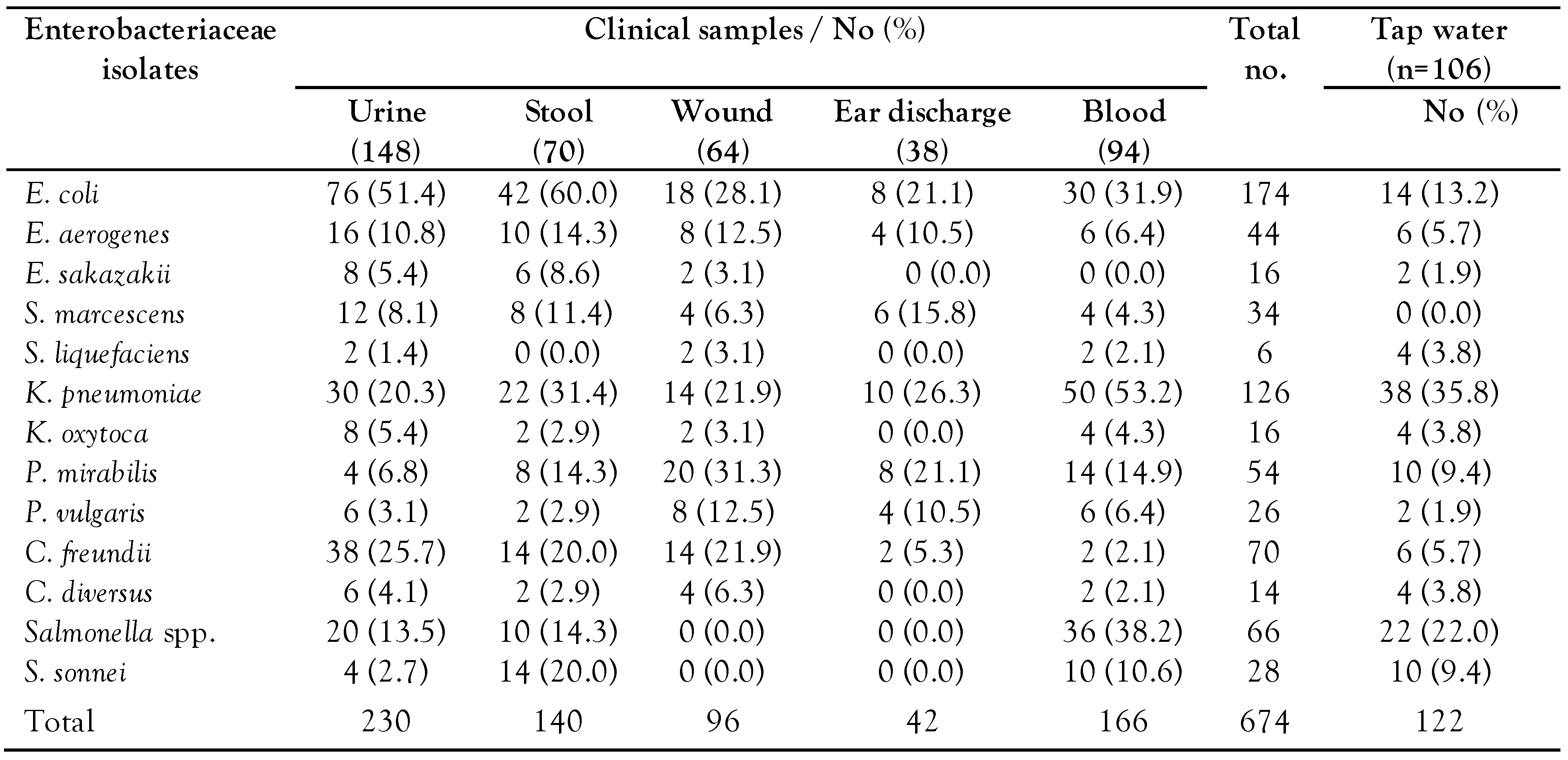
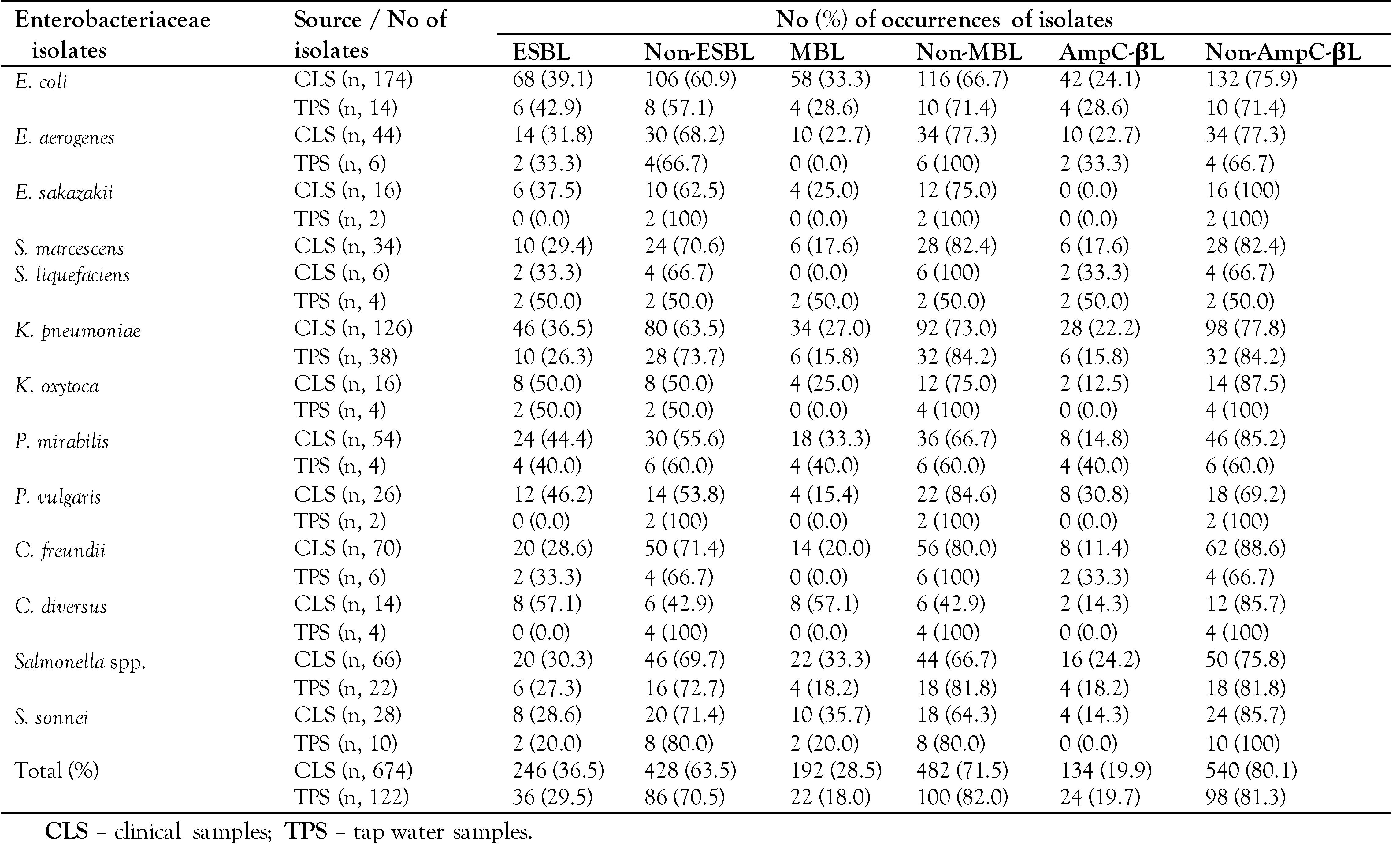
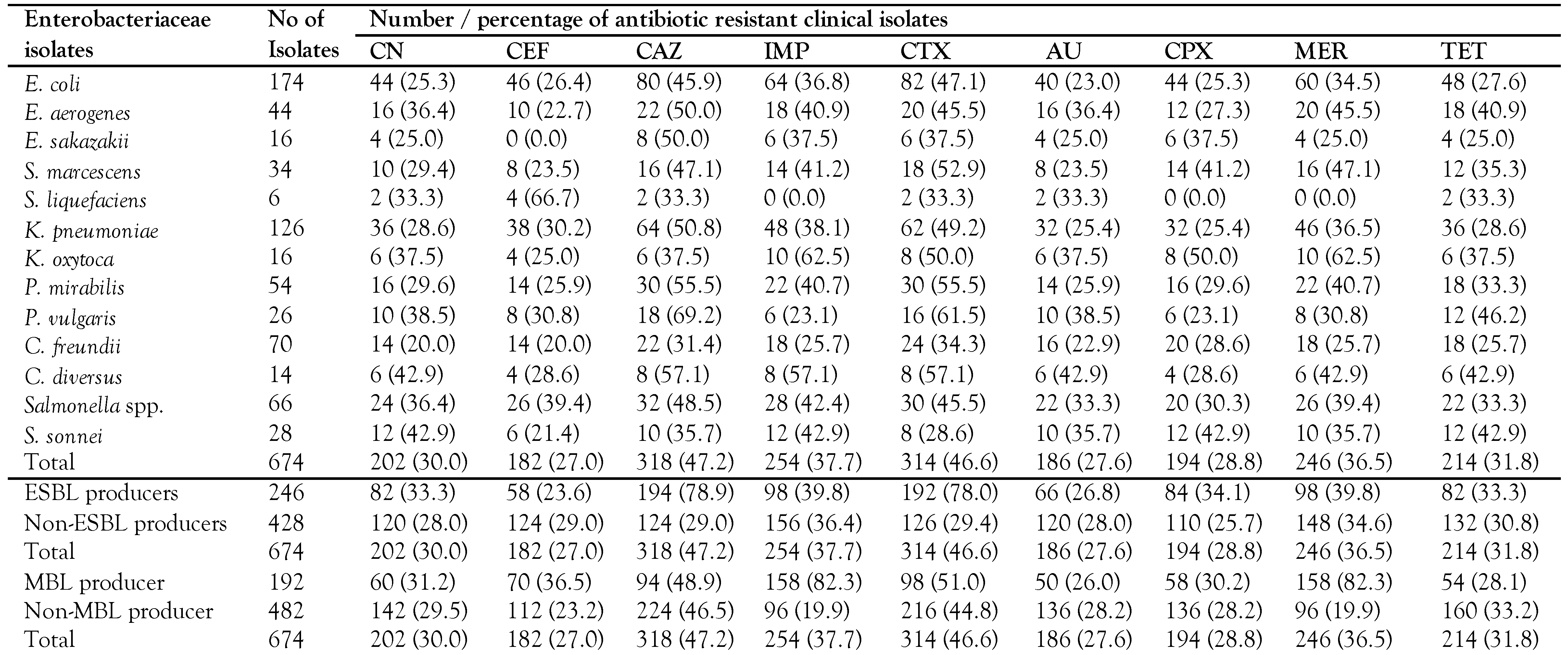
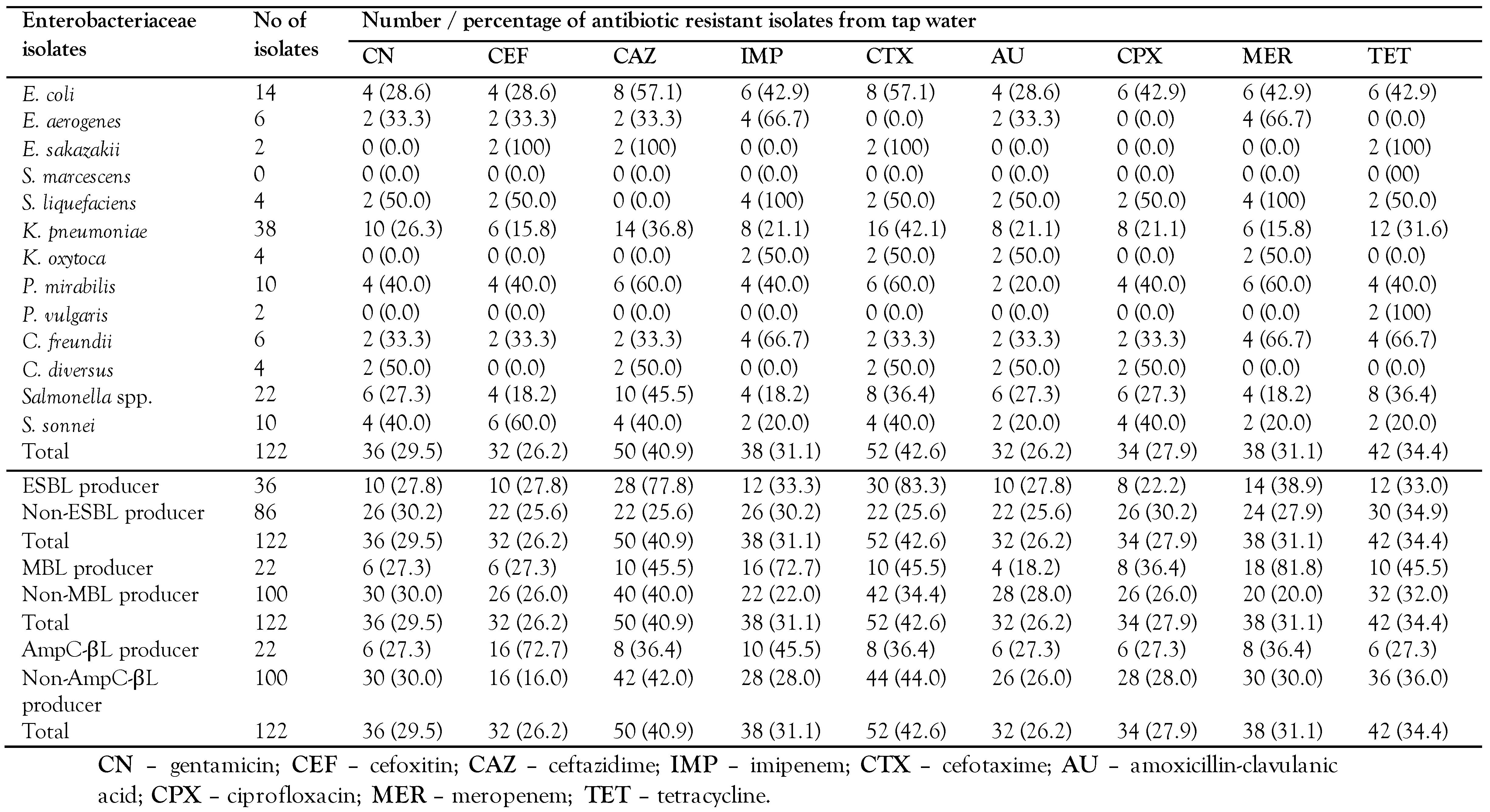
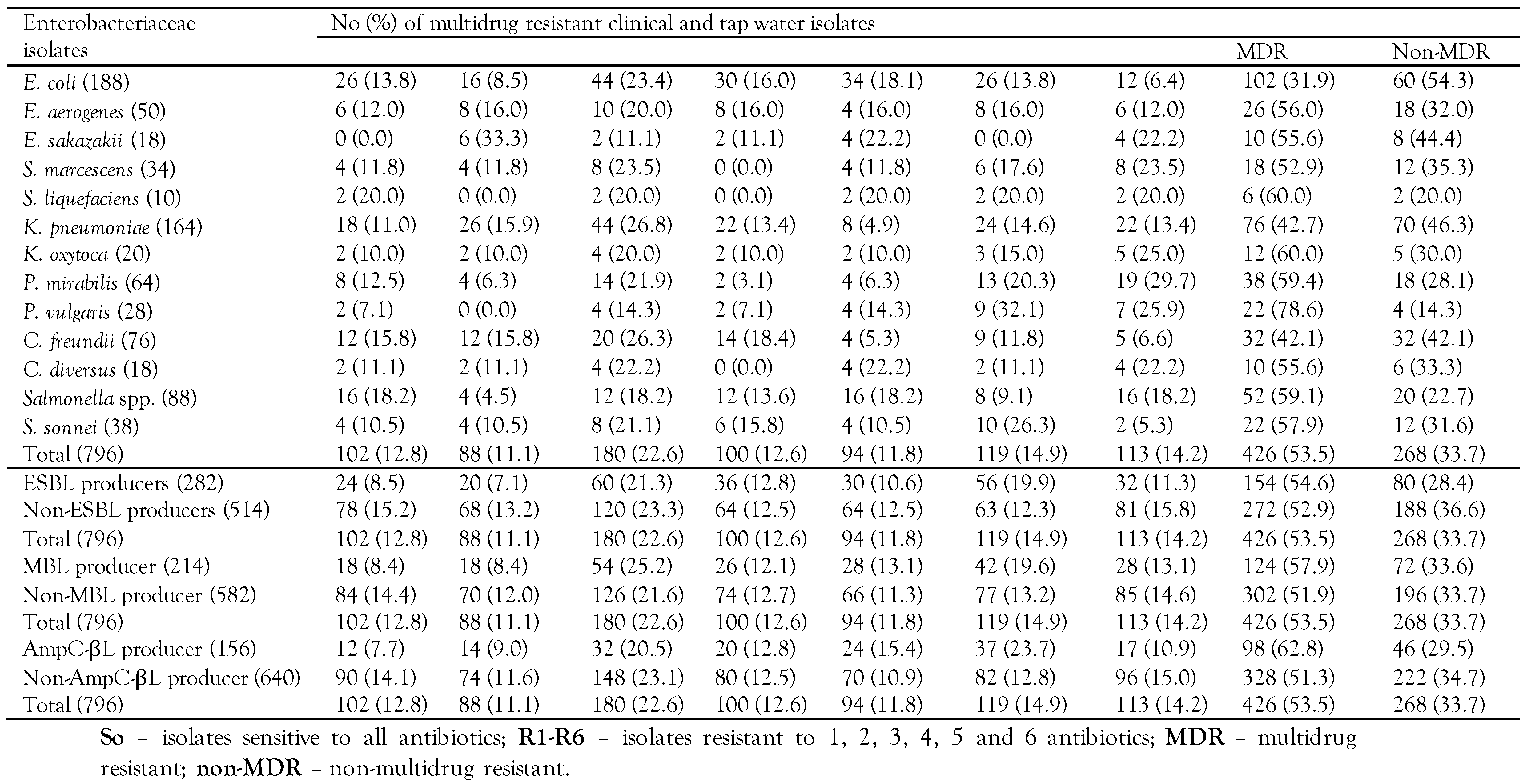
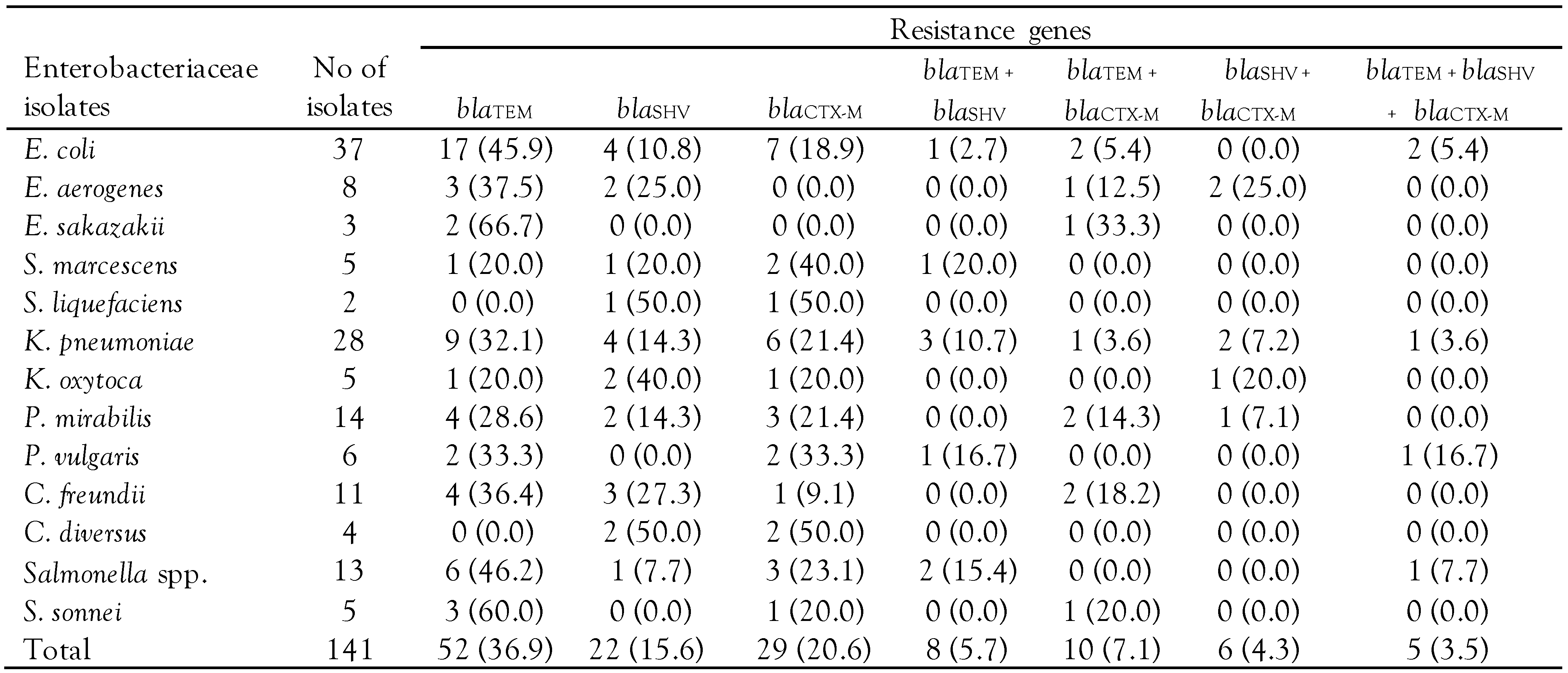
© GERMS 2023.
Share and Cite
Akinjogunla, O.J.; Odeyemi, A.T.; Udofia, E.-A.S.; Adefiranye, O.O.; Yah, C.S.; Ehinmore, I.; Etukudo, I.U. Enterobacteriaceae Isolates from Clinical and Household Tap Water Samples: Antibiotic Resistance, Screening for Extended-Spectrum, Metallo- and AmpC-Beta-Lactamases, and Detection of blaTEM, blaSHV and blaCTX-M in Uyo, Nigeria. GERMS 2023, 13, 50-59. https://doi.org/10.18683/germs.2023.1366
Akinjogunla OJ, Odeyemi AT, Udofia E-AS, Adefiranye OO, Yah CS, Ehinmore I, Etukudo IU. Enterobacteriaceae Isolates from Clinical and Household Tap Water Samples: Antibiotic Resistance, Screening for Extended-Spectrum, Metallo- and AmpC-Beta-Lactamases, and Detection of blaTEM, blaSHV and blaCTX-M in Uyo, Nigeria. GERMS. 2023; 13(1):50-59. https://doi.org/10.18683/germs.2023.1366
Chicago/Turabian StyleAkinjogunla, Olajide J., Adebowale T. Odeyemi, Edinam-Abasi S. Udofia, Oyetayo O. Adefiranye, Clarence S. Yah, Igbagbo Ehinmore, and Idongesit U. Etukudo. 2023. "Enterobacteriaceae Isolates from Clinical and Household Tap Water Samples: Antibiotic Resistance, Screening for Extended-Spectrum, Metallo- and AmpC-Beta-Lactamases, and Detection of blaTEM, blaSHV and blaCTX-M in Uyo, Nigeria" GERMS 13, no. 1: 50-59. https://doi.org/10.18683/germs.2023.1366
APA StyleAkinjogunla, O. J., Odeyemi, A. T., Udofia, E.-A. S., Adefiranye, O. O., Yah, C. S., Ehinmore, I., & Etukudo, I. U. (2023). Enterobacteriaceae Isolates from Clinical and Household Tap Water Samples: Antibiotic Resistance, Screening for Extended-Spectrum, Metallo- and AmpC-Beta-Lactamases, and Detection of blaTEM, blaSHV and blaCTX-M in Uyo, Nigeria. GERMS, 13(1), 50-59. https://doi.org/10.18683/germs.2023.1366




